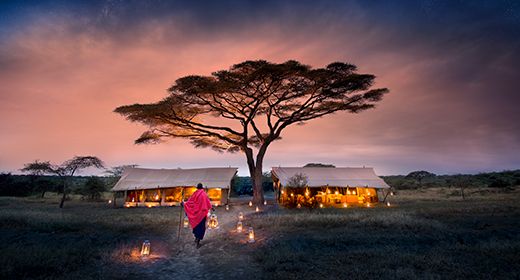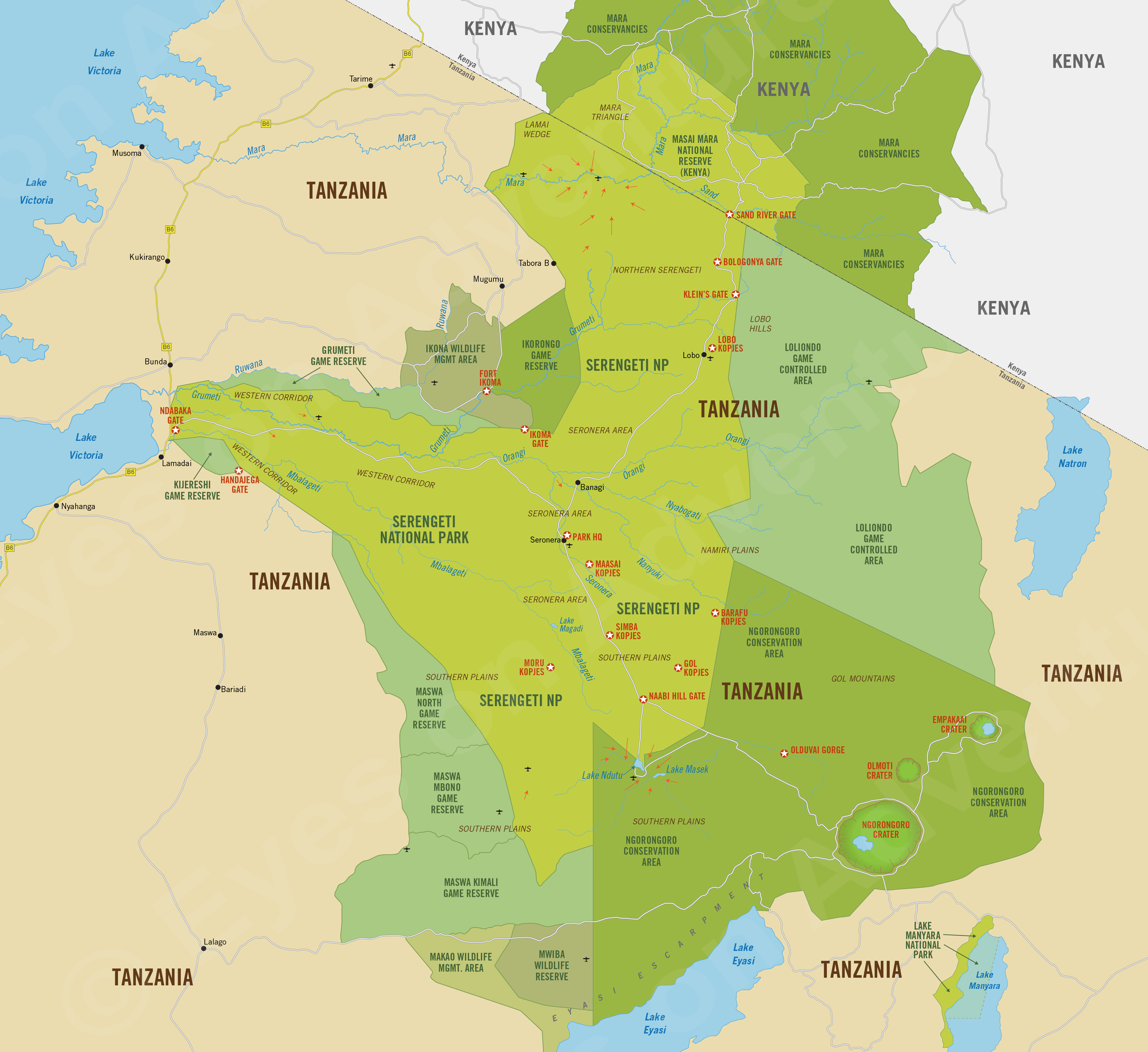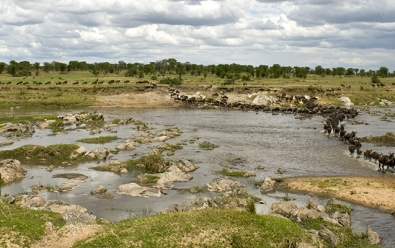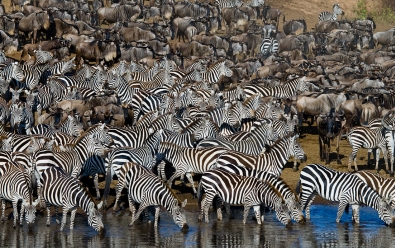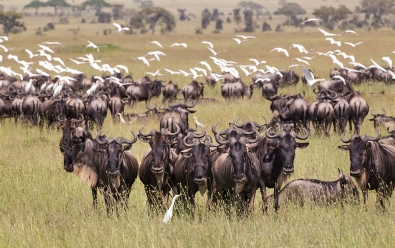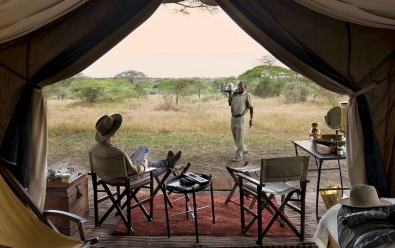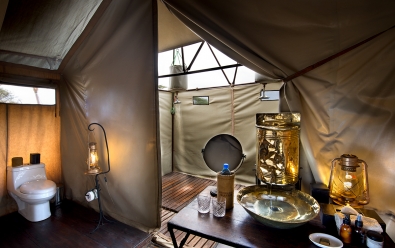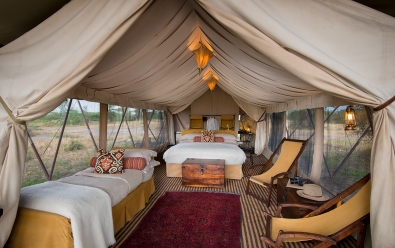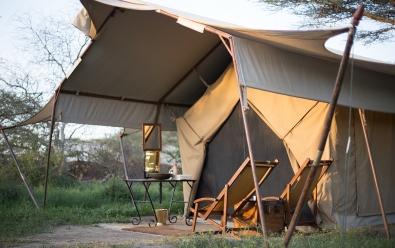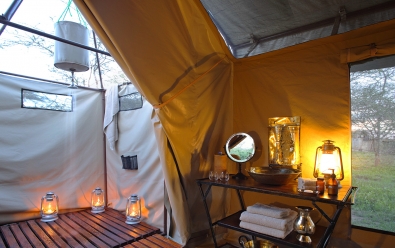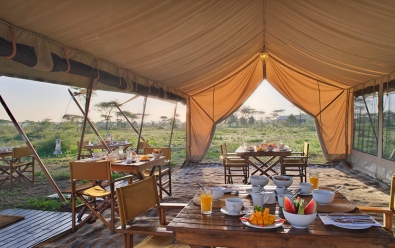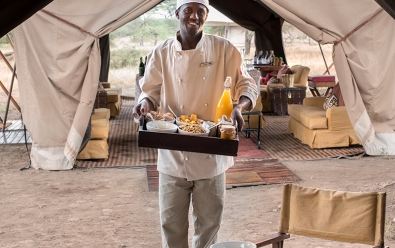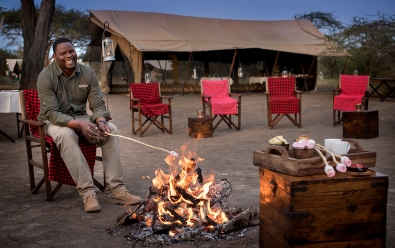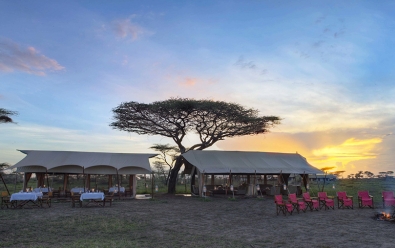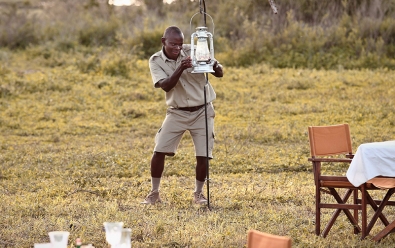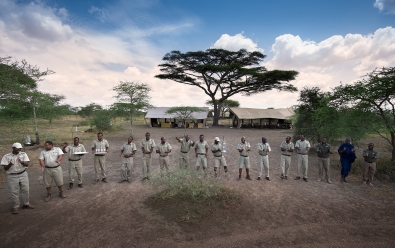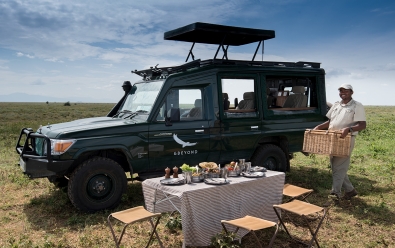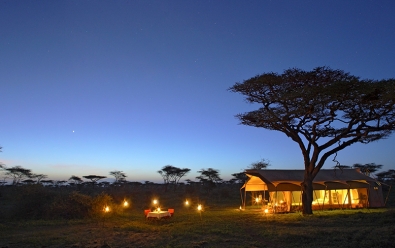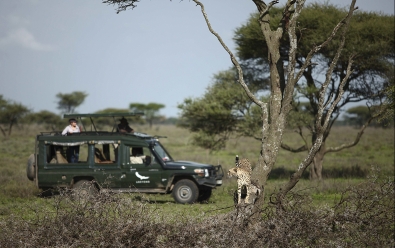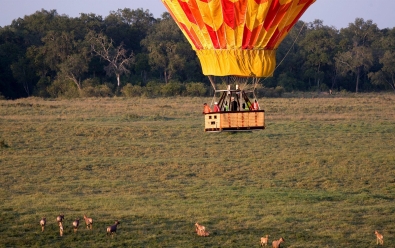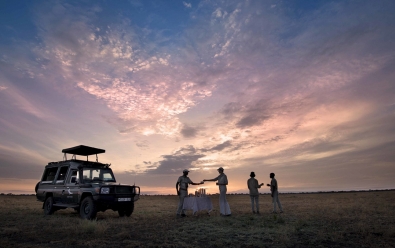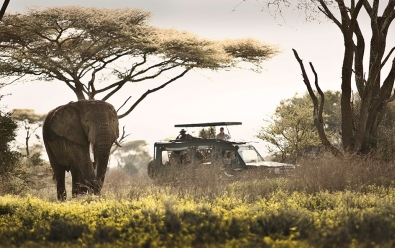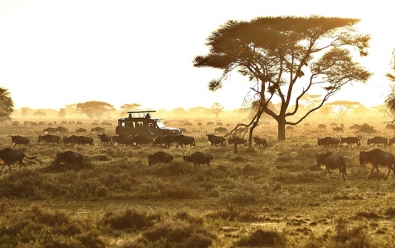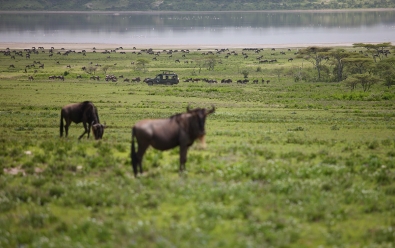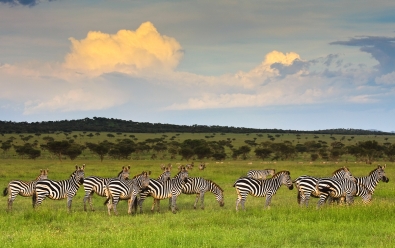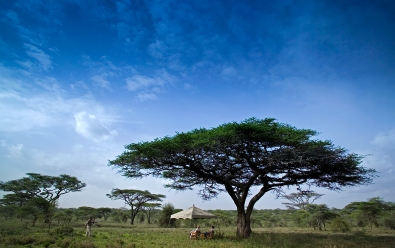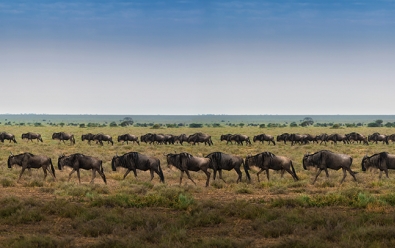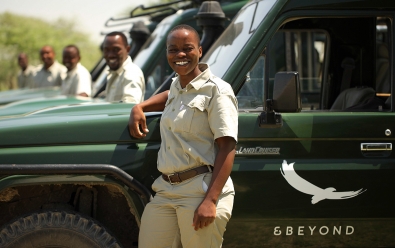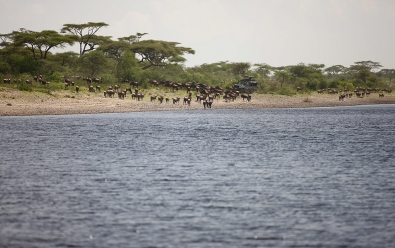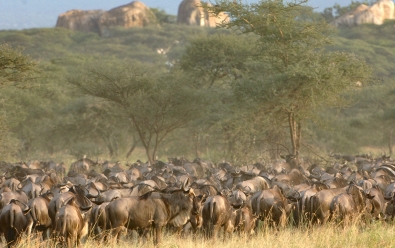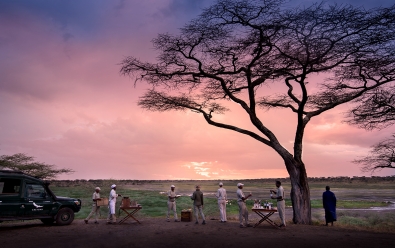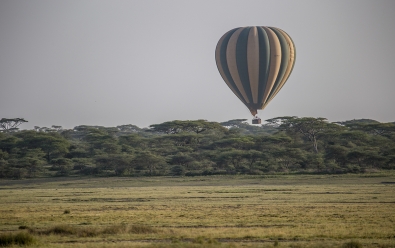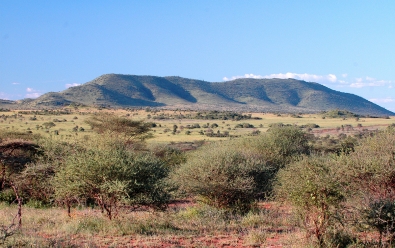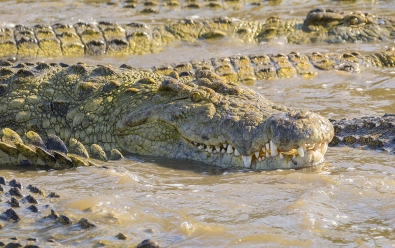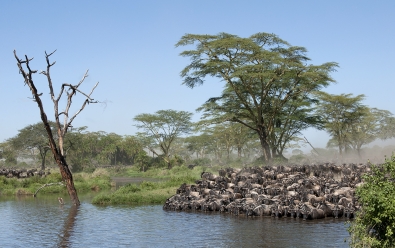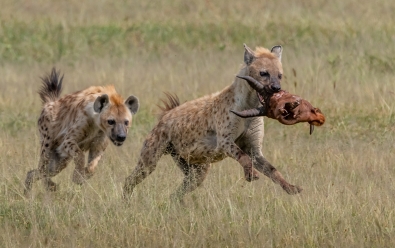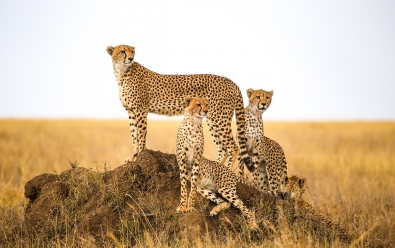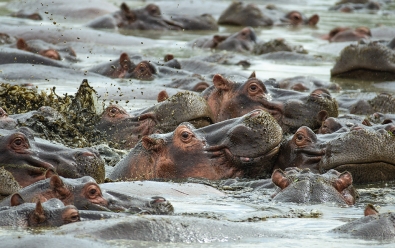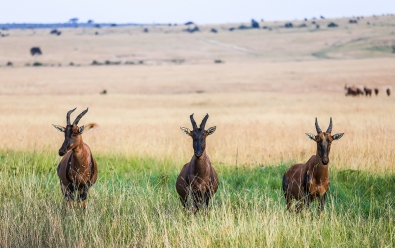Serengeti Under Canvas
Highlights
- Moves seasonally to be close to the Great Migration
- A truly luxurious mobile camping experience
- Choose from four camp locations in the Serengeti
- Offers excellent wildlife viewing throughout the year
Location
- Changes Seasonally
- Serengeti National Park
- Northern Tanzania
Serengeti under Canvas is a mobile safari camp that changes its location seasonally, positioning to bring guests as close as possible to the annual Great Migration.
The camp location changes five times per year, using four locations within Serengeti National Park (and in the Ngorongoro Conservation Area when at Ndutu). The seasonal movement of the camp is timed to be located near the great herds of over two million herbivores commonly known as the 'Great Migration' (read more about this below).
Serengeti under Canvas offers the ultimate in luxury mobile camping, with private butler service, chandeliers, silverware, crystal, ensuite flush toilets, outdoor heated bucket-style showers, and comfortable beds with fluffy duvets. Custom rugs and polished brass samovars add a touch of elegance and romance.
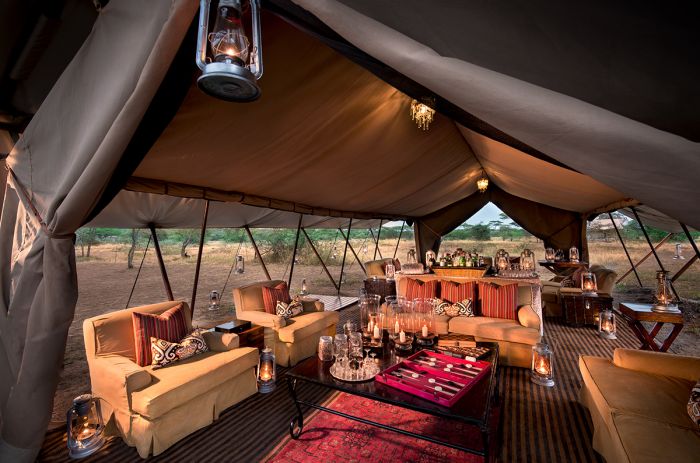
Serengeti under Canvas main area lounge and bar tent.
The camp is located in the following areas during the months indicated:
- Grumeti (Western Corridor): Jun, Jul
- Kogatende (Northern Serengeti): Aug, Sep, Oct
- Ndutu (Southern Serengeti / Ngorongoro Conservation Area): Dec, Jan, Feb, Mar
- Seronera (Central Serengeti): Apr, May, Nov
Note that the location of each seasonal camp Cana be seen on our interactive map in the header above.
Serengeti under Canvas consists of two separate, but closely situated campsites that move together as explained above. Each campsite offers 9 guest accommodations using classic, menu-style safari tents. One of the tents in each campsite is a double/family tent with an enclosed inter-leading passage connecting the two tents, one for the adults and the other for the children.
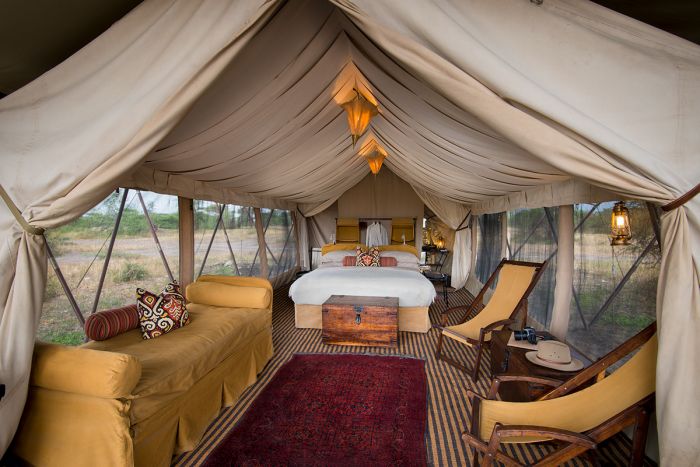
Guest tent interior at Serengeti under Canvas.
The spacious guest tents are quite luxurious for a mobile camping operation, with large, custom-made rugs, a daybed, polished brass sinks and fixtures, and crisp cotton linens. The en-suite facilities include side-by-side, hot-water bucket showers, and a flush toilet.
The main guest area includes two large canvas tents, one with comfy sofas and lounge chairs and the other which is used for dining, although outdoor, al fresco dining is also used. Sitting around the campfire to relive the day's excitement while enjoying the myriad stars is a great way to end each day.
Activities focus on twice-daily safari drives to see the wildlife of the Great Migration. Optional full-day trips to places like Olduvai Gorge or Lake Victoria are available depending on the camp's location and time of year. Hot-air ballooning over the Serengeti is another fantastic experience.
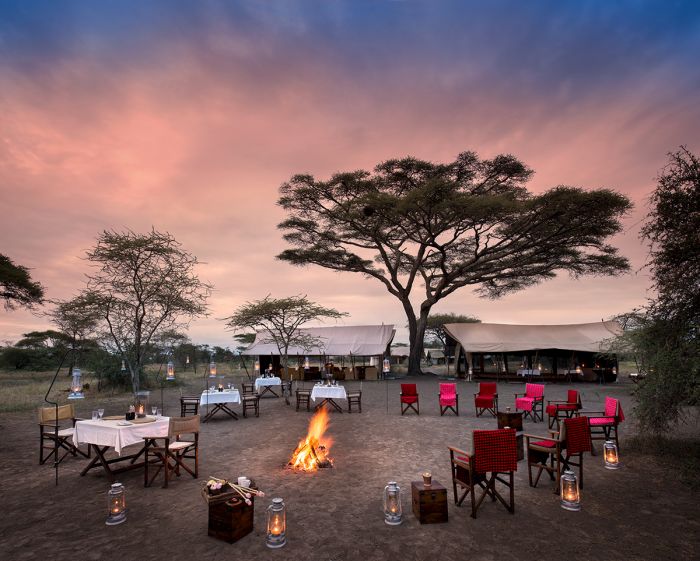
Main guest area at a Serengeti under Canvas camping site.
About the Serengeti
The Greater Serengeti is part of an extensive ecosystem that includes Serengeti National Park, the Ngorongoro Conservation Area, and other reserves, wildlife management areas, and game controlled areas.
The Greater Masai Mara (directly to the north in Kenya) includes the Masai Mara National Reserve, as well as numerous private Mara conservancies. Together, the combined Greater Serengeti-Mara ecosystem, which combines the areas described above, covers roughly 15 000 square miles (39 000 sq kms).
The Serengeti-Mara is home to a very large number and diversity of wild animals and is also the location of the well-known "Great Migration" of over 2 million herbivores (read more below). This is arguably Africa's greatest overall wildlife destination.
Wildlife densities in the Greater Serengeti are some of the highest in Africa, with commonly seen herbivores including blue wildebeest, plains zebra, Thomson's gazelle, topi, Grant's gazelle, hartebeest, giraffe, elephant, buffalo, impala, waterbuck, bushbuck, warthog, and many others. Predators seen often include lion, leopard, spotted hyena, cheetah, serval, and jackal. Hippo and crocodile are found in large numbers in the larger rivers, including the Mara River and the Grumeti River.
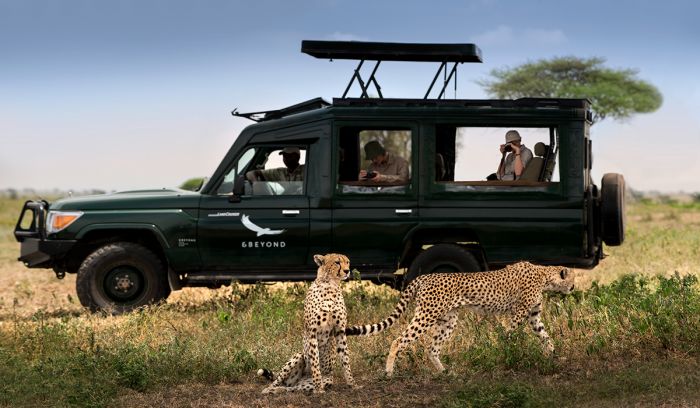
Cheetahs seen on a safari drive - Serengeti under Canvas.
The Great Migration
One of nature's greatest living spectacles is the Great Migration, a term given to describe the year-long, circular, clockwise march of over two million herbivores across the Serengeti and Masai Mara grasslands. The migration animals are made up entirely of two species: the blue wildebeest and the plains zebra (the majority of which are wildebeests).
The migrating herds follow their instincts to seek out fresh grazing and so the migration is ongoing, with the herds ever moving and taking a full year to complete a cycle across the Serengeti and Masai Mara. The animals move not as one herd, but as tens of thousands of animals in multiple herds of various sizes and spread out for many miles as they move.
The wildebeests and zebras take advantage of strongly seasonal conditions, spending the wet season (November through May) on the plains of Tanzania's Serengeti and the dry season in Kenya's Masai Mara. The wildebeests give birth between January and March on the short grass plains in the southern Serengeti.
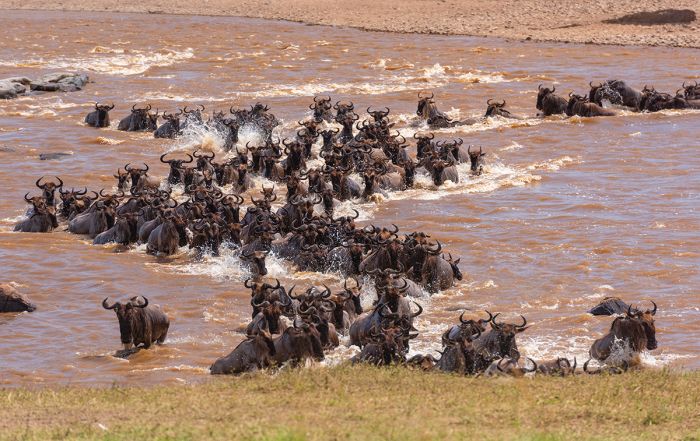
Wildebeests swimming across the Mara River in the Serengeti during the Great Migration.
The timing of the migration is rarely ever the same year-to-year, as local conditions influence grass growth and as such, the location of the bulk of there animals cannot be known precisely. Rains and other unknown conditions seem to direct the timing of the migration, but generally, it is known within several weeks when the animals will be in a general location.
The animals spread out to cover a vast area, but the main bulk of the animals moves south into the northern Serengeti around late-October and continue moving south towards the Serengeti's southern plains, arriving there sometime in January to graze on the rich grass growing on the volcanic soils. It is here on these short-grass plains, between January and early March, when the wildebeests give birth to their young en masse, producing some 500 000 baby wildebeests.
The herds remain on the southern short-grass plains until late March, giving the young animals time to grow and become strong, before heading north and west again. Many of the animals move towards the Serengeti's Western Corridor and Grumeti Reserve and the rest straight north into Central and Northern Serengeti, where they remain during June and into July. The herds move back into Kenya starting in late July, with the bulk moving into the Masai Mara in August.
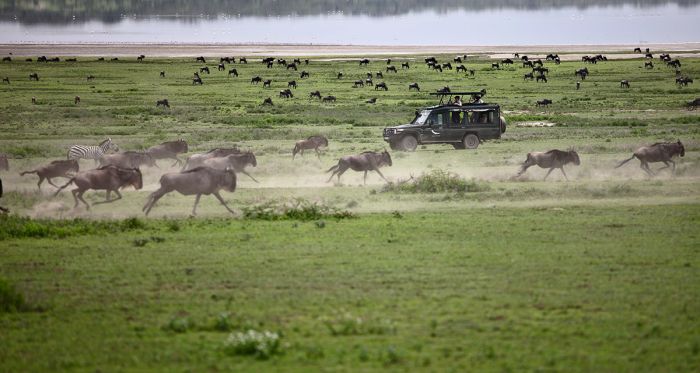
A game drive from Serengeti under Canvas at Ndutu (Southern Serengeti).
Although many visitors time their visit to the Serengeti to coincide with the Migration, any region within the Serengeti offers very good wildlife viewing outside of the months when the migration may be present. This is because it is only the wildebeests and zebras that migrate, while the rest of the animals, including the major predators like lion, leopard, spotted hyena, and cheetah, as well as all the other herbivores, including springbok, gazelles, elephant, topi, hartebeest, and many others, do not migrate.
A popular aspect of experiencing the Great Migration is observing a herd as it crosses the Mara River, which requires animals swimming through waters inhabited by large Nile crocodiles that wait for a chance to get their first substantial meal in many months.
The dramatic river crossings (which take place along the Mara River in both Kenya and Tanzania) are certainly a spectacle and not for the faint of heart, with many of the wildebeest and zebras taken by crocs or succumbing to drowning or trampling in the chaos. The best chances for seeing a Grumeti River crossing is in June, while Mara River crossings are best in July and August.
ROOMS INCLUDES & EXCLUDES CHILDREN FACILITIES ACTIVITIES
Seasonal Locations
Serengeti Under Canvas is a mobile safari camp (with two separate, but closely situated campsites) that moves seasonally to four different areas within Serengeti National Park throughout the course of the year.
The purpose of moving the camp is to have safari guests located as close as possible to the Great Migration of some 2 million herbivores (read more about the Great Migration on the Overview tab).
The camp is located in the following areas during the months indicated:
- Grumeti (Western Corridor): Jun, Jul
- Kogatende (Northern Serengeti): Aug, Sep, Oct
- Ndutu (Southern Serengeti / Ngorongoro Conservation Area): Dec, Jan, Feb, Mar
- Seronera (Central Serengeti): Apr, May, Nov
- Note that the dates at each location are subject to change based on the imprecise migrational movements of the animals in any given year.
The detailed locations of the camp are shown on our map in the header. Note that the exact location of the camp may change year-to-year based on the limited number of campsites available.
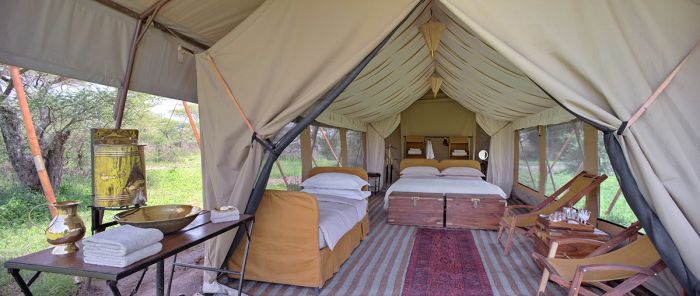
Guest tent (triple setup with child's bed) at Serengeti under Canvas.
Accommodation
There are two separate, but closely situated campsites, each with 9 guest accommodations comprising:
- 8 canvas, meru-style tents, each with two three-quarter beds (separate mattresses with shared base). Mattress converters are available that transform the twin beds into a double bed (to be arranged prior to arrival).
- 1 family tent, consisting of two standard tents connected by an enclosed inter-leading passage. The second (children's) tent is slightly smaller and has twin beds. Both tents have their own en-suite facilities at the rear, with two open-to-the-sky, but enclosed bucket showers, and a flush toilet. In front is a small veranda and seating area with a single-basin vanity.
All of the guest tents are set up on the ground with woven-fibre flooring, large oriental rugs, and en-suite facilities at the rear with two open-to-the-sky, but enclosed bucket showers and a flush toilet. In front is a small veranda and seating area with a single-basin vanity. The tents are located in proximity to the main campsite area.
One triple tent is available for each of the two camps. Note that the triple is only available within a campsite when the family tent is NOT booked.
The "under-canvas" safari-style tents are luxurious by mobile camp standards, with a daybed, custom-made rugs, polished brass sinks and fixtures, and crisp linens. The tents are comfortably-sized, covering 377 square feet (35 sq meters).
Other items and features in the guest tents include:
- Private veranda with chairs and small table.
- Personal bar.
- Complimentary pair of Swarovski binoculars (one per tent).
- In-tent Wi-Fi (also available in main guest area).
- Hairdryer available in the main guest area bathroom tent.
- In-room safe.
Each of the two separate camps can accommodate a maximum of 20 guests in total: 2 persons in each of the 8 standard tents and 4 persons (2 adults and two children 6 years and older) in the family tent.
Includes & Excludes
Includes:
- All meals and local beverages including soft drinks, house wines, local brand spirits and beers, teas, and coffees.
- Safari experiences (game drives, birding) accompanied by an experienced guide.
- Limited laundry services are provided on a daily basis (weather permitting, items will be returned on the same day). Laundry is dried by the sun and on most days any laundry placed out in the morning will be returned by the evening.
- A complimentary pair of Swarovski Optik CL Companion 8×30 binoculars per cottage/suite for use during your stay.
- Emergency medical evacuation insurance.
- Wi-Fi access.
- Tourism Levy & VAT.
Excludes:
- Hot-air ballooning.
- Champagne, cognacs, fine wines, premium brand spirits, and cigars.
- Telephone calls.
- Any applicable wildlife fee, park fee, reserve fee, concession fee, other land-use fee.
Single Supplement
A single supplement may apply for any room booked by a single traveler; please ask us for pricing.
Children
Families can rest assured that your children will always be safe and well cared for (both during activities and at the camp) by the lodge staff.
Children aged 6 years and older are accommodated at Serengeti under Canvas campsites:
- 1 triple available (only if the family suite is not booked).
- A maximum of two children (aged 6-16 years) can be accommodated at each of the two camps.
- Children under the age of 6 years are permitted only on a private vehicle or a children’s game drive (avoiding lion, leopard and elephants sightings), not during standard game drive time. No walks outside of the campsite.
- Children aged 6-11 years are permitted on game drives at the discretion of the camp manager and guides (private vehicle required).
- Children aged 6-11 years are not permitted on nature walks outside of the campsite.
- Children aged 12-15 years are permitted on game drives (private vehicle required) and nature walks.
- Private vehicle not required for children aged 16 years and older.
- Children that share a vehicle with other guests not in their party may be subject to activities only at the lodge manager’s discretion.
- Please note: The campsites are not fenced off and children are required to have an adult accompanying them at all times.
AndBeyond’s WILDchild programme, designed especially for children aged 3-12 years, is filled with fun, interactive activities that offer opportunities to learn and discover new experiences and cultures. Deeply rooted in the love for the African bush, it not only creates a series of unforgettable moments for the whole family, but forges strong bonds between young guests, our planet, and its people.
Wildchild activities include:
- Learn to play Bao.
- Bush survival - like the Maasai.
- Fashion a traditional Maasai bow and arrow and join a spear throwing competition.
- Fire making the Maasai way.
- Roasting marshmallows and stargazing.
Facilities
The main guest areas at the two campsites include a dedicated lounge and bar tent with deep sofas and comfortable lounge chairs, as well as an under-canvas dining tent.
Main guest area facilities include:
- Interactive kitchen.
- Complimentary Wi-Fi access (also available in the guest suites).
- Guest toilet tent in main area.
- Individual tables arranged outdoors (weather permitting) or inside the dining tent for meals.
- Hearty cuisine served on sparkling crystal and silver.
- Main area campfire to share stories of the day’s safari.
- Lanterns used for lighting in the main area.
- There is 220v AC power for charging in the safari vehicles.
- Central recharging station in main camp area (plug type is G/British).
- With advanced notice, the camp can arrange for a generator to provide 24-hour electricity for guests with special medical requirements.
- Hairdryer in main area toilet tent.
Activities
Activities included in the rate:
- Morning and afternoon/evening safari drives in semi-open 4x4 Land Cruisers. The vehicles are a mix of 4- and 6-seater.
- A complimentary pair of Swarovski Optik CL Companion 8×30 binoculars per guest tent for use during your stay.
- Birding.
- Stargazing.
Optional activities at additional cost:
- Private activities are on offer (subject to vehicle availability, which needs to be booked in advance).
- Hot-air ballooning. Age restrictions for children: Seronera and Grumeti - 7 years and older; Kogatende - 5 years and older.
- When the camp is in Ndutu (Southern Serengeti), explore the breathtaking surrounds of the Olduvai Gorge archaeological site, known also as the "cradle of mankind".
- When the camp is in Ndutu (Southern Serengeti), visit the crescent-shaped volcanic ash dunes knows as "Shifting Sands", which slowly creep across the desert floor in response to prevailing winds. This is usually combined with a visit to Olduvai Gorge.
- When the camp is in Grumeti (Western Corridor), enjoy a full-day trip to the shores of Lake Victoria, which promises a combination of wildlife adventures, sightseeing, fishing opportunities, and cultural insights. Optional activities during the day include a visit to Lukungu Primary School, a fishing excursion in a traditional canoe, a visit to a traditional doctor, or simply admiring the landscapes.
- Visit to a local Maasai boma (dependent on availability).
Example of a typical day:
- Early morning wake-up call. Morning wake-up and activity times vary according to the seasons, activities on offer, and wildlife sightings.
- Light breakfast before departing on the morning activity.
- Return to the camp for a meal and rest period.
- Meet for afternoon tea and snacks (savory and sweet choices) before departing on the activity.
- Return to camp - freshen up or meet for drinks, followed by dinner.
- Enjoy a nightcap and/or discussion around the campfire before retiring.
Great Good Fair Poor
- Jan
- Feb
- Mar
- Apr
- May
- Jun
- Jul
- Aug
- Sep
- Oct
- Nov
- Dec
General Tips
It is advised to avoid the Serengeti over March and April, when heavy rains typically occur. June to mid-October is excellent for general game viewing. The large herds of animals in the Great Migration usually cross into the Serengeti from Kenya's Masai Mara sometime around early October and move north back into Kenya around mid- to late-July.
Besides the Great Migration, the other big factor that impacts a stay in the Serengeti is rains. The region experiences most of its rain between November and May, but there are two somewhat distinct rain seasons, the 'short' rains and the 'long' rains (read more below).
Serengeti under Canvas is open in one of its locations year-round. See the Details tab for the applicable dates at each location.
Rains
Short Rains
The short rains occur for about one month sometime during November and December (the exact time varied somewhat year to year). This period is called the 'short' rains because the duration of an individual rain event is short and it is rare to have an all-day rain event. Most rain falls as an afternoon shower, while mornings are typically overcast or clear.
Long Rains
The long rains occur between March and May, with April being the wettest month of the year. During this tome, rain should be expected almost every day and the showers can last for hours at a time, although all-day rain is not typical. The roads in the Serengeti become muddy and very difficult in places, which can hamper game drives. Cloudy skies are typical and temperatures can be chilly at times.
The period between the short and long rains (January and February) also receives rain, but many days are clear and the amount and duration of the rain events is unpredictable, with some afternoon showers and the odd long and heavy rainfall event.
Temperatures
The temperatures in the Greater Serengeti do not experience wide fluctuation throughout the year, as the region lies between one and three degrees south of the equator. In general, daytime temperatures are comfortably warm and overnights and early mornings are chilly. Bring a fleece and rain jacket regardless of the timing of your visit.
Dry Season
The dry season (June to October) is sunny and warm most days and rarely hot. Rare rain showers can occur but are unlikely. From June thru August, the afternoon temperature averages 76-78°F (24-25°C), but some days can be warmer. Evenings and early mornings temperatures are often chilly, averaging 53-55°F (12-13°C).
September and October days are very pleasant, with temperatures averaging 80-83°F (28-30°C), with cool mornings persisting, averaging 53-56°F (11-13°C).
Rainy Season
The rain season is November through May (read more above) and the temperatures are fairly static throughout the season. Daytime temperatures average 79-83°F (26-28°C) and nighttime and early morning temperatures are chilly, but slightly warmer than the dry season, averaging 54-57°F (12-14°C)
The Great Migration
The annual movement of wildebeest and zebras across the Serengeti-Mara ecosystem is one of the greatest spectacles in the natural world. These large herds move in a circular track across southern Kenya and northern Tanzania, taking a full year to complete their cycle. The migration moves across both the Greater Masai Mara (in Kenya) and the Greater Serengeti (in Tanzania) in a fairly consistent pattern and timeframe. The animals move to take advantage of fresh grasses on which to graze.
The migrating herds of roughly 1.5 million blue wildebeests and several hundred thousand plains zebras spend about nine months of the year moving through Tanzania's Greater Serengeti and the other three months in Kenya's Greater Masai Mara. The migrating herds are in Tanzania's Greater Serengeti from sometime in October until around late-July (note that the timing is never precise and varies somewhat year to year). Note that the Serengeti is vast, and it is important to note where in the region the herds are located during this nine-month timeframe.
The animals spread out to cover a vast area, but the main bulk of the animals moves south into the northern Serengeti around late-October and continue moving south towards the Serengeti's southern plains, arriving there sometime in January to graze on the rich grass growing on the volcanic soils. It is here on these short-grass plains, between January and early March, when the wildebeests give birth to their young en masse, producing some 500 000 baby wildebeests.
The herds remain on the southern short-grass plains until late March, giving the young animals time to grow and become strong, before heading north and west again. Many of the animals move towards the Serengeti's Western Corridor and Grumeti Reserve and the rest straight north into Central and Northern Serengeti, where they remain during June and into July. The herds move back into Kenya starting in late July, with the bulk moving into the Masai Mara in August.
The migration is rarely ever the same in terms of precise timing and direction, as local rains and other conditions influence grass growth. The wildebeest may, therefore, move off the open plains earlier in some years and remain in the northern Serengeti for longer in others. Nonetheless, the best months for seeing the migration in the Southern Serengeti are in February and March, when the herds are adding new babies, in the Central Serengeti during May and June, when the herds are the most concentrated, and in the Western Corridor, Grumeti, and far Northern Serengeti from June thru August.
Many visitors hope to witness dramatic river crossings, when hungry crocodiles attack the herds as they swim across the dangerous rivers of the Northern Serengeti. Like the migration in general, the precise timing of the river crossings is never known from year to year, but crossings on the Grumeti River are usually best in June, while Mara River crossings are best in July and August.




